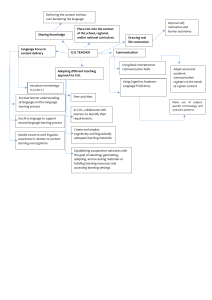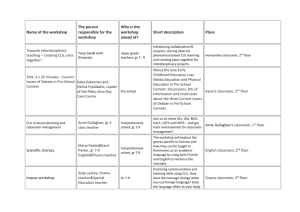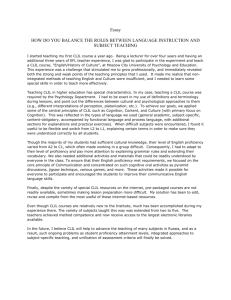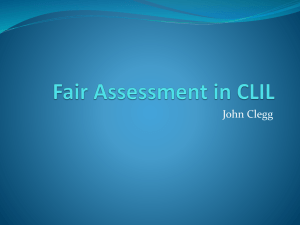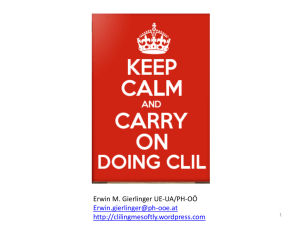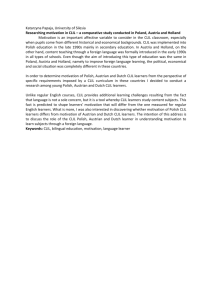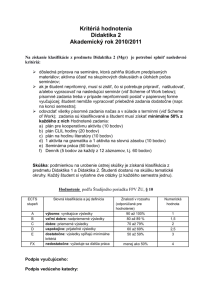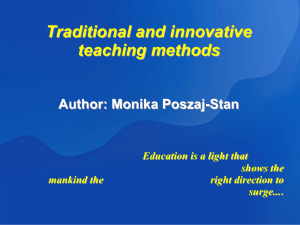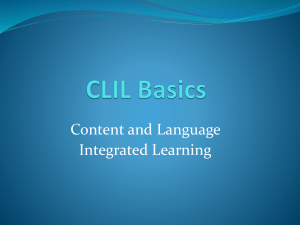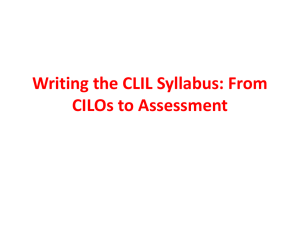CLIL
advertisement
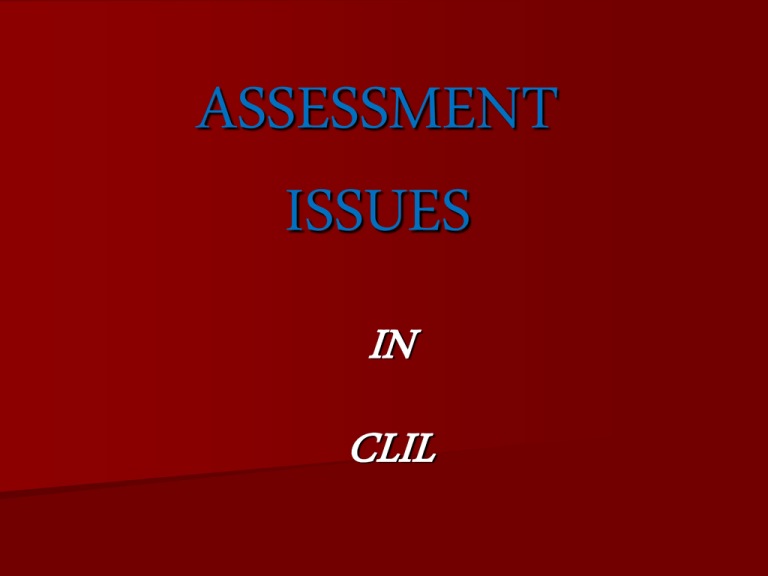
ASSESSMENT ISSUES IN CLIL ASSESSMENT PROCESSES SUMMATIVE Makes a judgement on the capability of the learner at a certain point in time Leads to some form of infogiving to another party (ex., school management/parents) It is associated with formal testing (end-of-unit, final result) FORMATIVE It is more complex Its intention is diagnostic It has an impact on the learner’s next step It is also formative for the teacher, because it can alter planning CLARKE (2001) SUMMATIVE The simple measurement of a plant FORMATIVE The feeding process which leads to growth AfL (Assessment for Learning) Black, William, UK, 1998 – 2002 KEY PRINCIPLES • THE SHARING OF LEARNING INTENTIONS Teachers tell students at the beginning of the lessons what they will learn • THE USE OF SUCCESS CRITERIA Students will be told what the task will involve and what the outcome will contain • THE IMPORTANCE OF FEEDBACK which affects the learner’s self-esteem and should positively impact on motivation We Will Focus On FORMATIVE ASSESSMENT WHY? because it is to be used on a regular basis because it promotes learning and, therefore, better summative results because it is INSIDE, not OUTSIDE the teaching/learning process/activities because it is CONTINUOUS and within classroom practice MAYOR QUESTIONS o o o o o o o What do we assess? CONTENT or LANGUAGE? In what language do we assess? What tools can we use for assessment? How can we assess previous knowledge and/or progression? How can we minimize the effects of the language in the content assessment? How can we evaluate the skills/processes? How can/should we assess group work? 3 BASIC ISSUES Do we assess content, language, or both? Which is more Important? How do we do this? (Who assesses, When, how) The fact is, that CLIL Units must have CLEAR OBJECTIVES What really matters is PRIORITY. In my opinion, being CONTENT TEACHERS, CLIL teachers should always have CONTENT as dominant OBJECTIVE. Then, of course, language will be learnt in the process. Therefore, CONTENT first, then LANGUAGE 1. ASSESSING CONTENT Basic Principles CONTENT OBJECTIVES should be the same for native or secondlanguage speakers BUT CLIL teachers should choose a method of assessment which uses the least language CONTENT is clear and wide in the STUDENT’S MIND BUT When it comes to communicating it to someone else, MOUTHS are SLOW 2. WHICH ASPECT of the CONTENT are we ASSESSING? Factual knowledge (checking detail) General Understanding (Major points) Ability to manipulate content (interpretaion/analysis/synthesis/application) 3. If we focus on CONCRETE objectives, THEN regular assessment opportunities COME!! We should propose purposeful learning activities, which involve students in thinking and problemsolving, in pairs or in groups In this way, it may not be necessary to create a specific TEST, because the activities themselves can be used for monitoring and can provide real evidence of learning 4. If a 3-part lesson is implemented, LESSON STARTER Introducing: Brainstorming, Visuals, Questions MAIN ACTIVITIES Task-based Set by the teacher Monitor/observe PLENARY T/SS together summarize the learning, in order to move on THEN, assessment will not always deal with individuals, but also with groups of learners It may be difficult to decide who knows what, but this is less important, because the FINAL OUTPUT MAY BE MORE THAN THE SUM OF ALL THE PARTS In addition, such tasks raise different areas for assessment: - teamwork - project work - self assessment 1. ASSESSING LANGUAGE To begin with, just as with content, we need to be sure which aspect of language we are assessing: Subject-specific vocabulary Listen/read for meaning Present/discuss effectively Demonstrate thinking/reasoning in the CLIL language Show awareness of grammatical features of the language 2. HOW TO ASSESS LANGUAGE: through a variety of approaches CONSTRUCTED RESPONSE Fill-in Short answers Performance assessment SELECTED RESPONSE True/False Matching Multiple choice PERSONAL RESPONSE Portfolio Essay-writing Oral reports ALTERNATIVE ASSESSMENT FORMATS It requires little language knowledge to stimulate content recall • It activates/organizes thinking • Once completed, the grid can be used for a further task, involving pair work (negotiating) • A. RECORDING TO A GRID ALTERNATIVE ASSESSMENT FORMATS Matching pictures to vocabulary True/false Gap-filling from a box Decision task: two versions are given and the correct one has to be chosen B. READING Visual texts of all types ALTERNATIVE ASSESSMENT FORMATS With this format, demonstrating comprehension should always involve real decision based on concept understanding. (Ex.: matching sentence halves) o The focus is on MEANING o C. MATCHING INFORMATION ALTERNATIVE ASSESSMENT FORMATS The simplest of all the productive formats, it comes in single-word form. Very useful at elementary level, or in the introductionphase of the lesson LABELLING ALTERNATIVE ASSESSMENT FORMATS • • OTHER PRODUCTIVE FORMATS • • They are more complex When you want your students to SPEAK or WRITE, they need a MODEL They also need SCAFFOLDING activities (note-taking, fill-in a grid) First in PAIRS/GROUPS, then INDIVIDUALLY SUMMARY 1. 2. 3. Clear Learning OBJECTIVES; they will usually include CONTENT/SKILLS first, then LANGUAGE in some form Because of INTEGRATION and DUAL FOCUS, in CLIL lessons we cannot always assess everything We shloud use a mixture of formal/informal assessment, which is both task-based and assignment based SUMMARY 4. 5. 6. Learners should be aware of assessment measures and success criteria, expressed in a student-friendly format Content knowledge should be assessed using the simplest form of language which is appropriate for that purpose Language should be assessed for a real purpose in a real context – sometimes it will be for form/accuracy, sometimes for communicative competence/fluency SUMMARY 7. 8. If assessment is orally-based, then WAIT TIME is crucial (thinking and expressing what they tink takes time!!) SCAFFOLDING is not CHEATING. We need to assess what students can do with support, before we assess what they can do without it.
